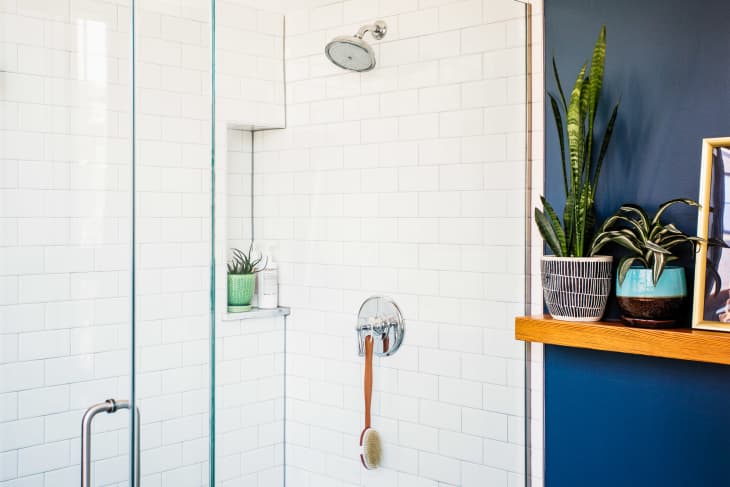The $1 Drug Store Item That Keeps My Bathroom Shower Sparkling Clean

Our bathroom shower has been a hot mess lately — quite literally. The crank on the casement window broke, so we’ve had to keep it closed despite it being summer. It’s now clear that we need a new exhaust fan because, without the additional ventilation of that open window, the tile isn’t drying as quickly after a shower.
How to Use Hydrogen Peroxide to Clean the Shower
First, store hydrogen peroxide in a dark-colored spray bottle to keep it stable. Then, spray on tile and grout and let sit for at least 10 minutes. Make sure the room is well-ventilated. Finally, wipe the tile and grout with a sponge.
What did I do on my summer vacation? I went on a successful mission to combat mold. My weapon of choice? Hydrogen peroxide.
Why Hydrogen Peroxide Works as a Cleaner
Hydrogen peroxide can safely clean and disinfect surfaces, making it an effective and economical cleaning product, especially for bathrooms. (It can even disinfect dishes in the kitchen sink.) Years ago, it was hailed as the go-to for cleaning cuts and scrapes — you might remember the sting! — but medical experts at the Cleveland Clinic and elsewhere advise not using it in that capacity anymore because it’s too irritating for the skin.
Also, make sure you never mix hydrogen peroxide with vinegar, which can create peracetic acid, a corrosive and harmful acid. They can be used in succession but not at the same time.
That said, hydrogen peroxide is still much gentler than other chemical-based products — looking at you, bleach-based cleaners! — and I have a clean shower to prove it.
How to Use Hydrogen Peroxide to Clean the Shower
You can purchase hydrogen peroxide at your local drugstore or other retail shops. I spent the “enormous” sum of $1 to buy an ordinary bottle of 3% hydrogen peroxide from Target and poured some into a dark-colored spray bottle (more on that in a bit). Walgreens sells it at the same price, too. Then, I sprayed the tile and grout and let it sit for about 10 minutes.
Hydrogen peroxide might be an ingredient in things like toothpaste and mouthwash, but you should still take proper precautions. Since I can’t currently open the bathroom window easily, I kept the door open and turned on the wonky exhaust fan to vent the room.
I noticed there was no unpleasant smell that you get with some of the harsher bleach-based cleaning products I’ve used in the past. But that doesn’t mean it doesn’t work. You can hear it fizzing as it does, and when I wiped the tile with a sponge, it looked and felt as clean as it was the day the tile was first installed.
I know I need to do that thing where you soak the shower head in a vinegar bath overnight to descale it, but since I had the bottle of hydrogen peroxide, I gave it a spritz, too. There was an immediate difference, and when I swiped it with the sponge a few times, it looked almost as good as new.
How to Store Hydrogen Peroxide Properly
Four bottles of this hydrogen peroxide cost about the same as one bottle of bleach cleaner. Does that mean I now have hydrogen peroxide on auto-order? You betcha. If you decide to do the same, note that you can’t just store hydrogen peroxide any old way if you want it to remain effective.
Remember when I said that I use a dark spray bottle? That’s not just for drama or aesthetics; the opaque bottle keeps the hydrogen peroxide stable by keeping sunlight out so the solution can retain its extra oxygen molecule. (That’s why hydrogen peroxide usually comes in that dark brown bottle you see at the drugstore.) Lose that and you’ve just got plain old water. That might help rinse off my shower tile, but it won’t do much to clean it.
I’ve been going through my bottle of hydrogen peroxide fairly quickly, so I won’t have to wonder whether it’s still effective. But if you’ve had your bottle on hand for a while, test it out by spraying or pouring some on the floor of your tub or shower. If it fizzes, you’re good to go. If not, it’s time to buy a new bottle.